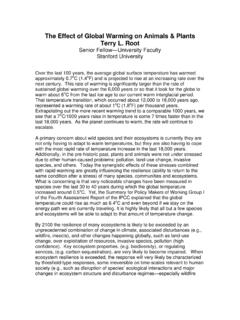Transcription of Buildings Account for 39% of CO2 emissions in the …
1 Buildings Account for 39% of CO2 emissions in the United States The commercial and residential building sector accounts for 39% of carbon dioxide (CO2). emissions in the United States per year, more than any other sector. Buildings alone are responsible for more CO2 emissions annually than those of any other country except China. Most of these emissions come from the combustion of fossil fuels to provide heating, cooling and lighting, and to power appliances and electrical equipment. By transforming the built environment to be more energy-efficient and climate-friendly, the building sector can play a major role in reducing the threat of climate change. A growing source of CO2 emissions : In 2004, total emissions from residential CO2 emissions from Fossil Fuels and commercial Buildings were 2236. million metric tons of CO2, or 39% of total CO2 emissions more than either the transportation or industrial Industry sectors Buildings 29%.
2 39%. Over the next 25 years, CO2 emissions from Buildings are projected to grow Transport faster than any other sector, with 33%. emissions from commercial Buildings projected to grow the fastest a year through 2030. When other CO2 emissions attributable to Buildings are considered such as the emissions from the manufacture and transport of building construction and demolition materials and transportation associated with urban sprawl the result is an even greater impact on the climate Buildings consume 70% of the electricity load in the The most significant factor contributing to CO2 emissions from Buildings is their use of electricity: Commercial and residential Buildings are tremendous users of electricity, accounting for more than 70% of electricity use in the The building sector consumed 40 quadrillion Btus of energy in 2005 at a cost of over $300 billion.
3 Energy use in the sector is projected to increase to 50 quadrillion Btus at a cost of $430 billion by the year 2025. The energy impact of Buildings is likely to be even greater when taking into Account other energy use attributable to Buildings . For example, the energy embodied in a single building 's envelope equals 8-10 times the annual energy used to heat and cool the building . Buildings have a lifespan of 50-100 years during which they continually consume energy and produce CO2 emissions . If half of new commercial Buildings were built to use 50% less energy, it would save over 6 million metric tons of CO2 annually for the life of the Buildings the equivalent of taking more than 1 million cars off the road every year. 15 million new Buildings are projected to be constructed by 2015. The population and economy are projected to grow significantly over the coming decades, increasing the need for new Buildings : To meet this demand, approximately 15 million new Buildings are projected to be constructed by 2015.
4 Absent significant improvements in environmental performance, the building sector will be a major contributor to increasing global CO2 emissions . Green Buildings are a vital tool in the fight against climate change Scientists predict that left unchecked, emissions of CO2 and other greenhouse gases from human activities will raise global temperatures by F to 10 F this century. The effects will be profound, and may include rising sea levels, more frequent floods and droughts, and increased spread of infectious diseases. To address the threat of climate change, greenhouse gas emissions must be slowed, stopped, and reversed. Meeting the challenge will require dramatic advances in technologies and a shift in how the world economy generates and uses energy. building green is one of the best strategies for meeting the challenge of climate change because the technology to make substantial reductions in energy and CO2 emissions already exists.
5 The average LEED certified building uses 32% less electricity and saves 350 metric tons of CO2 emissions annually. Modest investments in energy-saving and other climate-friendly technologies can yield Buildings and communities that are environmentally responsible, profitable and healthier places to live and work, and that contribute to reducing CO2 emissions . Green Buildings provide abundant opportunities for saving energy and mitigating CO2 emissions building green can reduce CO2 emissions while improving the bottom line through energy and other savings. Examples of measures that can be taken to improve building performance include: Incorporating the most efficient heating, ventilation and air conditioning systems, along with operations and maintenance of such systems to assure optimum performance Using state of the art lighting and optimizing daylighting Using recycled content building and interior materials Reducing potable water usage Using renewable energy Implementing proper construction waste management Siting the building near public transportation Using locally produced building materials











